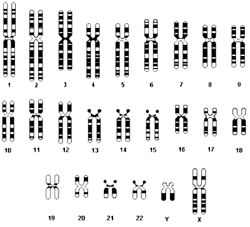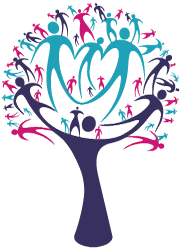About Genes
Genes are passed from parents to their children and are sets of instructions which make each of us an individual. These genes determine how our bodies will work and control many things, for example, what colour your hair and eyes will be, the size of your feet and hands, what blood group you will belong to, how well your hearing will be, functioning of kidneys and heart etc.
Sometimes, these genes can be damaged, missing or a change can occur in them which can then cause a health problem.
Everybody should have 2 copies of each gene and this is because we get a copy of each gene from our parents, for example one gene for eye colour from mum and one from dad.
DNA
 DNA is the scientific word for what carries genes in all living things. You may have seen images of DNA molecules which look like two strands wrapped around each other. DNA is carried in all parts and organs of the body including the blood.
DNA is the scientific word for what carries genes in all living things. You may have seen images of DNA molecules which look like two strands wrapped around each other. DNA is carried in all parts and organs of the body including the blood.
Chromosomes
 Chromosomes are structures containing long strands of DNA (which contains the genes). Genes are arranged one after the other on a chromosome. Humans have 23 pairs of chromosomes and each parent gives one chromosome for each pair. Some are bigger than others and so some contain more genetic information (instructions for your body) than others.
Chromosomes are structures containing long strands of DNA (which contains the genes). Genes are arranged one after the other on a chromosome. Humans have 23 pairs of chromosomes and each parent gives one chromosome for each pair. Some are bigger than others and so some contain more genetic information (instructions for your body) than others.
Sex Chromosomes
The 23rd /last pair of chromosomes are also known as the sex chromosomes. Females are made up of 2 ‘X’ chromosomes whereas males have 1 ‘X’ and 1 ‘Y’ chromosome, this is what makes them male. A mother can only pass on a ‘X’ chromosome to her child (she has two ‘X’s’) whereas a father can pass either an ‘X’ or a ‘Y’ (he has an ‘X’ and a ‘Y’ as he is male). If he passes an ‘X’ the child will be a girl and if he passes a ‘Y’ it will be a boy, however this is at random and cannot be controlled without medical intervention.
Altered/Changed Gene
An altered or changed gene is when something goes wrong with a healthy gene and it is no longer able to give the correct instructions to the body. A genetic counsellor can sometimes help to find why you or your child have certain disabilities by finding which gene has changed and what this might mean for you. The effect of the mutation or change depends on which chromosome the gene is changed in.
Inherit/Inherited
Inherit is when something has been passed on from one person to another. Therefore to “inherit” a gene refers to when a gene is passed on from a parent to their child. A child can inherit a changed gene from their parents which can result in a genetic condition.
Genetic Condition/Disorder
Genetic disorder refers to an illness or disorder which is caused by a changed gene. There are thousands of genetic conditions/disorders varying in symptoms and severity and they do not all occur in the same way. Some genetic conditions are not passed on from parents but occur at random through either chance changes in genes, genes missing on chromosomes or sometimes genes moving to the wrong chromosome. Some genetic conditions can be passed on from parents and this can happen in three different way (see Recessive inheritance, Dominant inheritance and X-linked inheritance).
Because of this it is very important to see a genetic counsellor as the risk of inheriting a genetic condition can differ from condition to condition and from family to family.
Healthy Carrier
All humans should inherit two copies of each gene (one from mum and one from dad). If we inherit a changed gene for a recessive condition from one of our parents, as long as we inherit a healthy one from the other we will not have the genetic condition. This is because the healthy gene will do the work for both of them. Therefore this person is known as a “healthy” (as they have a healthy gene) “carrier” (as they also carry a changed gene which doesn’t affect them).
Recessive Inheritance
In this form of inheritance a person has to inherit two copies of the changed gene (one from mum and one from dad) for them to be affected by the genetic condition.
When both parents are healthy carriers of a genetic condition each time they are pregnant there is a 25% chance of having a child with a recessive condition. This chance remains the same for all pregnancies and is the same for males and females. There is also a 50% chance that the child will inherit just one faulty copy of the gene from the parent and will be a healthy carrier like them. However a number of testing options are available for people who have a family history of recessive genetic disorders especially when planning pregnancies.
X-Linked Inheritance
Females inherit one X chromosome from their father and one X chromosome from their mother which gives them the feminine characteristics, whereas males inherit an X chromosome from their mother and the Y from their father giving them the masculine characteristics.
The X chromosome is big and has many genes on it, whereas the Y is smaller and contains fewer genes. Sometimes a problem occurs on a gene in the X chromosome which means the body is receiving incorrect information on how to do something, for example how the kidneys should work, resulting in a genetic condition.
This pattern of inheritance usually affects boys in a family. Girls are born with two X chromosomes, so if one does not work properly the other will cover the work of the affected X chromosome and there will usually be no condition/illness. However with some disorders females may still have some symptoms of the condition, for example with a condition called fragile X. However boys only have one X-chromosome, so if they inherit one with a changed or missing gene, they will be affected with the condition as the Y is smaller and cannot cover the work.
Autosomal Dominant Inheritance
Some conditions are caused by a changed gene in the pair which is dominant. This means that the dominant gene will take over the healthy gene whether it is from the mother or the father and cause a health problem. In dominant inheritance, there is a 50% chance of passing on an illness to a child in each pregnancy, regardless of their sex.
So on average half of the children can be affected and the other half unaffected. However, as chance determines inheritance, it is possible that all or none of the children will be affected.
Consanguinity
Consanguinity refers to when two people are connected by the same blood or a common ancestor. Therefore a consanguineous marriage is when two people who have the same blood (so are cousins) marry one another i.e. cousin marriage.
As cousins share the same blood, they also share similar DNA (which carries their genes) which can sometimes increase the risk of them inheriting certain genetic conditions.

